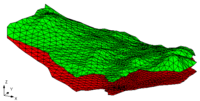GMS:Creating a TIN: Difference between revisions
From XMS Wiki
Jump to navigationJump to search
No edit summary |
No edit summary |
||
| (10 intermediate revisions by 2 users not shown) | |||
| Line 2: | Line 2: | ||
In order to create a TIN in GMS, there must be a set of TIN vertices. Then the TIN is created by triangulating the vertices (connecting the vertices with lines to form triangles). The [[GMS:Triangulation|triangulation]] algorithm assumes that each of the vertices being triangulated is unique in the xy plane, i.e., no two points have the same xy location. Duplicate points can be removed by selecting '''Find Duplicates''' from the ''TINs'' menu. | In order to create a TIN in GMS, there must be a set of TIN vertices. Then the TIN is created by triangulating the vertices (connecting the vertices with lines to form triangles). The [[GMS:Triangulation|triangulation]] algorithm assumes that each of the vertices being triangulated is unique in the xy plane, i.e., no two points have the same xy location. Duplicate points can be removed by selecting '''Find Duplicates''' from the ''TINs'' menu. | ||
TINs can be created | TINs can be created three different ways in GMS: manually entering the vertex locations and triangulating, converting a different GMS data type to a TIN, and copying a currently existing TIN. | ||
=== Manually Creating a TIN === | === Manually Creating a TIN === | ||
| Line 17: | Line 17: | ||
[[GMS:2D Mesh Module|2D meshes]], [[GMS:2D Grid Module|2D grids]], and [[GMS:2D Scatter Point Module|2D scatter points]] can all be converted to a TIN. This is accomplished by using the following commands: | [[GMS:2D Mesh Module|2D meshes]], [[GMS:2D Grid Module|2D grids]], and [[GMS:2D Scatter Point Module|2D scatter points]] can all be converted to a TIN. This is accomplished by using the following commands: | ||
;[[GMS:Converting_a_2D_Mesh_to_Other_Types_of_Data#Mesh_.E2.86.92_TIN|Mesh to TIN]] : A triangle is created from each triangular element in the mesh. | |||
;[[GMS:Converting_2D_Grids#Grid_.E2.86.92_TIN|Grid to TIN]] : Creates a new TIN from the selected 2D grid. | |||
;[[GMS:Converting 2D Scatter Points to Other Types of Data|Scatter Points to TIN]] : Creates a set of TIN vertices. | |||
;[[GMS:Converting Borehole Data|Contacts to TIN]] : Creates a TIN surface from a set of selected contacts. | |||
;[[GMS:Converting Borehole Data|Watertable to TIN]] : Uses water table coordinates from a set of boreholes to converted to TIN. | |||
;Add Contacts to TIN : This command is used to enter a point from a contact into the active TIN . The contact(s) are first selected and the command is then chosen from the ''Borehole'' menu. Typically all contacts which should be part of a TIN are selected before generating the TIN, but sometimes one is inadvertently left out, or more boreholes are added later. | |||
=== Copying a Current TIN === | === Copying a Current TIN === | ||
| Line 28: | Line 28: | ||
#Select the TIN to be copied using the '''Select TINs''' tool. | #Select the TIN to be copied using the '''Select TINs''' tool. | ||
#Select the '''Duplicate TIN''' command from the | #Select the '''Duplicate TIN''' command from the right-click menu. A dialog appears prompting for the Z-offset of the new TIN. The Z offset is used to displace the TIN above or below the TIN being duplicated. | ||
{{Navbox GMS}} | {{Navbox GMS}} | ||
[[Category:TINs]] | [[Category:TINs]] | ||
